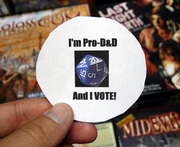
Apparently, I am mistaken. Apparently, in addition to the above type trademark, Johnson and Johnson also claims the exclusive use of the red cross.
The American Red Cross, with whom Johnson and Johnson has an agreement dating back more than a century, which gives the American Red Cross the ability to use the symbol for its non-profit work. However, now that, in trying to raise money for the non-profit work, the Red Cross sells things with the red cross on it. They also license the trademark to others to get royalties, money which goes to fund their disaster relief projects.
Since they have started using the symbol for "commercial" activities, apparently Johnson and Johnson is up in arms trying to protect "its" trademark. In their statement, the company states their justification by complaining,
Johnson & Johnson began using the Red Cross design and "Red Cross" word trademarks in 1887, predating the formation of the American Red Cross. The Company has had exclusive rights to use the Red Cross trademark on commercial products within its longstanding product categories for over 100 years. Since its creation, the American Red Cross has at all times possessed only the rights to use the Red Cross trademark in connection with its non-profit relief services.The American Red Cross on the other hand fired back with their press release. In it, they stated,
After more than a century of strong cooperation in the use of the Red Cross trademark, with both organizations respecting the legal boundaries for each others' unique legal rights, we were very disappointed to find that the American Red Cross started a campaign to license the trademark to several businesses for commercial purposes on all types of products being sold in many different retail and other commercial outlets. These products include baby mitts, nail clippers, combs, toothbrushes and humidifiers. This action is in direct violation of a Federal statute protecting the mark as well as in violation of our longstanding trademark rights.
The Red Cross has been selling first aid kits commercially in the United States since 1903. Until now, J&J has never challenged this activity. In fact, for over 100 years, J&J and the Red Cross have enjoyed their concurrent right to use the Red Cross emblem.The rest of the response can be found here.
By offering Red Cross first aid, health, safety and emergency preparedness products at retail locations, the Red Cross is reaching more families and making it easier for Americans to get prepared. The money the Red Cross receives in the sale of these products to consumers is reinvested in its humanitarian programs and services.
The Red Cross, a nonprofit, received only $2 million in revenue from the sale of its products in 2006. J&J, a corporation, received $53.3 billion in annual revenue in 2006.
“We hope that Johnson & Johnson will act as a good corporate citizen and recognize the right of the American Red Cross to our own emblem to carry out our mission—not stand in the way,” Everson said.
“Our legal argument is based on solid substantiated facts,” he continued. “J&J has taken a criminal statute intended by Congress to protect the American Red Cross and is now using it to distort history and the law.”
At first glance, and this is without going into the whole question of who used the symbol first, what the law actually says, or what agreements may not have existed, some jury may be asked to decide between a Pharmaceutical giant who makes $53 billion a year versus a non-profit who makes a couple of million a year and then uses the money to pay for programs which help save lives in the wake of tragedies.
Could Johnson and Johnson have found a more sympathetic defendant to go after?
And remember, that's before we get to the fun questions of who was using the mark first (ARC seems to make the case that they were), of what the agreement said or even if it existed, and what the law says.
Patent Baristas has a much better look at this.





No comments:
Post a Comment